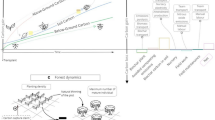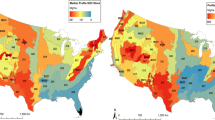Abstract
Among the objectives of afforestation projects, carbon sequestration is attracting increasing political attention. Therefore, there is a need for understanding the carbon sequestration ‘mechanism’ and for ex-ante assessment of the sequestration potential of afforestation projects. Such assessment must be based on parameter estimates that are inherently uncertain, making the basis for applying an advanced sequestration model weak. This paper presents a transparent, simple and general model for quantification of the carbon sequestration in afforestation projects. The model can easily be modified so as to fit specific conditions, and it is held sufficiently reliable when taking into account the ex-ante character of the decision problem. The use of the model is exemplified by application to a yield table for Sitka spruce. Limitations of the model framework and its application in combination with scenarios of climate change are discussed.


Similar content being viewed by others
References
Brazier JD (1967) Timber improvement I. A study of the variation in wood characteristics in young Sitka spruce. Forestry 40:117–128
Brown P, Cabarle B, Livernash R (1997) Carbon counts–estimating climate change mitigation projects in forestry projects. World Resources Institute, Washington, DC
Cannell MGR, Dewar RC (1995) The carbon sink provided by plantation forests and their products in Britain. Forestry 68:35–48
Cannell MGR, Cruickshank MM, Mobbs DC (1996) Carbon storage and sequestration in the forests of Northern Ireland. Forestry 69:155–165
Cooper CF (1983) Carbon storage in managed forests. Can J For Res 13:155–166
Cropper WP, Ewel KC (1984) Carbon storage patterns in Douglas-fir ecosystems. Can J For Res 14:855–859
Dewar RC (1990) A model of carbon storage in forests and forest products. Tree Physiol 6:417–428
Dewar RC (1991) Analytical model of carbon storage in the trees, soils and wood products of managed forests. Tree Physiol 8:239–258
Dewar RC, Cannell MGR (1992) Carbon sequestration in the trees, products and soils of forest plantations: an analysis using UK examples. Tree Physiol 11:49–71
Grier CC, Logan RS (1977) Old-growth Pseudotsuga menziesii communities of a western Oregon watershed: biomass distribution and production budgets. Ecol Monogr 47:373–400
Hamilton GJ (1985) Forest Mensuration Handbook. Forestry Commission Booklet No. 35, HMSO, London
Hamilton GJ, Christie JM (1971) Forest Management Tables (Metric), Forestry Commission, London
Harvald C, Olesen PO (1987) The variation of basic density within the juvenile wood of Sitka spruce (Picea sitchensis). Scand J For Res 2:525–537
Karjalainen T (1996) Dynamics and potentials of carbon sequestration in managed stands and wood products in Finland under changing climatic conditions. For Ecol Manage 80:113–132
Keyes MR, Grier CC (1981) Above- and below-ground net production in 40-year-old Douglas-fir stands on low and high productivity sites. Can J For Res 11:599–605
Lee JJ, Dodson R (1996) Potential carbon sequestration by afforestation of pastures in the South-Central United States. Agron J 88:381–384
Ley E, Sedjo RA (1997) Carbon sequestration and tree plantations: a case study from Argentina. Crit Rev Environ Sci Technol 27(Special): 185–192
Lust N, van Camp N, Muys B, Nachtergale L (1995) Comparative study of C sequestration by new forests on former pasture lands. Silva Gandav 60:81–94
Masera OR, Garza-Caligaris JF, Kanninen M, Karjalainen T, Liski J, Nabuurs GJ, Pussinen A, de Jong BH, Mohren GMJ (2003) Modeling carbon sequestration in afforestation, agroforestry and forest management projects: the CO2FIX V.2 approach. Ecol Model 164:177–199
Whittaker RH, Bormann FH, Likens GE, Siccama TG (1974) The Hubbard Brook ecosystem study: forest biomass and production. Ecol Monogr 44:233–254
Author information
Authors and Affiliations
Corresponding author
Appendix
Appendix
Models and assumptions
To describe the cumulative volume increment as a function of stand age and yield class, the following model is applied:
where V(t, Y) is cumulative volume increment, t is stand age in years, and Y is yield class (measured in m3 ha−1 year−1).
For Hamilton and Christie’s (1971) yield table for Sitka spruce (Picea sitchensis (Bong.) Carr.) the parameter estimates are: α = −16.0059; \( \beta_{0} \) = 108.117; \( \beta_{1} \) = 76.3119; \( \gamma_{0} \) = 0.053188; \( \gamma_{1} \) = −0.000627; \( \delta_{0} \) = 0.935271; \( \delta_{1} \) = −0.011508.
Due to its origin, V(t, Y) expresses the production of stem wood to a top diameter of 7 cm (m3/ha). What we are really interested in, however, is an expression emphasising the total assimilation of carbon as measured in Mg C ha−1 or Mg CO2 ha−1. To arrive at suitable conversion factors we need to consider three aspects: (1) the average basic density of stem wood, (2) the relationship between assimilation allocated to stem biomass and total net assimilation (stems, branches, leaves, and roots), and (3) the equivalent amount of C or CO2.
Based on Brazier (1967) and Harvald and Olesen (1987) the average basic density of Sitka spruce is estimated at 350 kg/m3. Dewar and Cannell (1992) applied the same density estimate (on the basis of Hamilton (1985)). Moreover, according to studies like those of Whittaker et al. (1974), Grier and Logan (1977), Keyes and Grier (1981) and Lust et al. (1995) stem and branch wood usually constitute 50–75% of the total biomass of the standing crop. Hence, as V(t, Y) is the cumulative increment of merchantable stem volume with a top diameter of 7 cm, we assume the biomass corresponding to V(t, Y) to constitute 50% of the total biomass production.
The carbon content of plants is generally assumed to amount to roughly 50% of the biomass (e.g. Dewar and Cannell 1992; Lust et al. 1995). Furthermore, the molar weight of C is 12.01 g/mol and that of CO2 is 44.00 g/mol. Accordingly, 1 Mg C is equivalent to 44.00/12.01 = 3.664 Mg CO2.
Using the above assumptions, the cumulative net C or CO2 assimilation, A(t, Y), is given by:
and the required assimilation function a(t, Y) is the derivative of this.
As to the thinning function, h(·), we have chosen to use a discrete function which removes 40% of the net assimilation every fifth year from the first thinning to the end of the rotation. Thus, h(t, Y) is given by:
where t is current stand age and t 1 is age at first thinning; t 1 is chosen as the age where the stand reaches a top height of 8.0 m. The top height corresponding to Hamilton and Christie’s (1971) yield table is calculated using the function:
Furthermore, we have (arbitrarily) defined the natural loss, l(t, Y), as 2% of the current standing stock, i.e.:
Finally, the following values have been chosen for the four decomposition rates: r h = 0.12, r l = 0.09, r f = 0.06, and r p = 0.03. These decomposition rates correspond to half-lives of 5.78, 7.70, 11.55, and 23.10 years, respectively. For comparison the half-life applied by Karjalainen (1996) for products with a short lifespan was 4 years and that of products with a medium-long lifespan 30 years. As regards the final harvest only about 50% of the timber, corresponding to 25% of the biomass, will end up in products with a medium-long lifespan. In the thinning the proportion of products with a medium-long lifespan will be much lower. As for r p , Dewar and Cannell (1992) applied a fractional decomposition rate of 0.03 for soil organic matter. This corresponds to a half-life of 22.7 years, i.e. almost the same as for r p = 0.03.
The sequestration potential is considered for yield classes ranging from 6 to 24 m3 ha−1 year−1. Clearly, the average rotation age can be expected to vary considerably for this wide range of site types. To avoid more specific assumptions about the relationship between site quality and rotation age, we have chosen to let the rotation age depend linearly on yield class, i.e.:
where \( Y_{\min } \) = 6 m3 ha−1 year−1, \( Y_{\max } \) = 24 m3 ha−1 year−1, \( T(Y_{\min } ) \) = 100 years, and \( T(Y_{\max } ) \) = 50 years.
Similarly, the initial size of the carbon pool, P 0, is assumed to depend linearly on site quality. The assumed values of P 0,min and P 0,max, corresponding to \( Y_{\min } \) and \( Y_{\max } \) are 30 and 60 Mg C ha−1 (110 and 220 Mg CO2 ha−1), respectively.
Based on the functions and assumptions described above, all other elements of the model (cf. Table 1) can be derived using the principles described in the paper.
Rights and permissions
About this article
Cite this article
Meilby, H., Helles, F. A general model for assessment of the carbon sequestration potential of afforestation projects. New Forests 42, 383–396 (2011). https://doi.org/10.1007/s11056-011-9259-7
Received:
Accepted:
Published:
Issue Date:
DOI: https://doi.org/10.1007/s11056-011-9259-7




